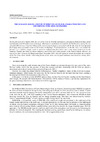Identificador persistente para citar o vincular este elemento:
https://accedacris.ulpgc.es/jspui/handle/10553/77037
| Título: | The 31 march 2002 Sta. Cruz de Tenerife flash flood: characteristics and differences with similar episodes | Autores/as: | Cana, L. Grisolía-Santos, D. Sancho, P. |
Clasificación UNESCO: | 250207 Climatología regional | Fecha de publicación: | 2003 | Editor/a: | Universitat des Illes Balears | Conferencia: | 4th EGS Plinius Conference | Resumen: | On the afternoon of 31 March 2002, the city of Sta. Cruz de Tenerife experienced a devastating flash flood that caused eight fatalities and 20 million euros in damage. Maximum accumulations of rainfall in the Northeastern part of the city exceeded 200 mm in a 3-h period. Many of the meteorological features associated with the Sta. Cruz de Tenerife flash flood typify those of similar events in the Canary Archipelago. Prominent features in the Sta. Cruz case include the presence of a 500-hPa trough; weak to moderate southwesterly flow below and a deep moist warm layer in the sounding. Usually, the Polar Jet stream influences most of the heavy rain episodes in the Canary Islands. However, in contrast to other events as the Maspalomas flood (November 2001), the subtropical jet stream determines the evolution of the Sta. Cruz storm. Another interesting feature of the storm was its quasi-stationary movement in a strong shear environment. | URI: | https://accedacris.ulpgc.es/handle/10553/77037 | Fuente: | Proceedings of the 4th EGS Plinius Conference held at Mallorca, Spain, October 2002 |
| Colección: | Actas de congresos |
Visitas
181
actualizado el 27-sep-2025
Descargas
101
actualizado el 27-sep-2025
Google ScholarTM
Verifica
Comparte
Exporta metadatos
Los elementos en ULPGC accedaCRIS están protegidos por derechos de autor con todos los derechos reservados, a menos que se indique lo contrario.
